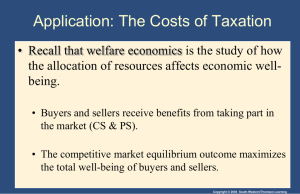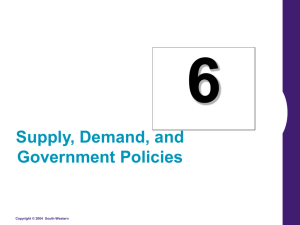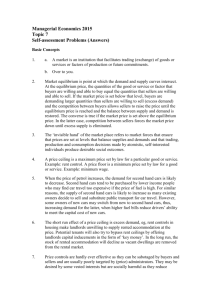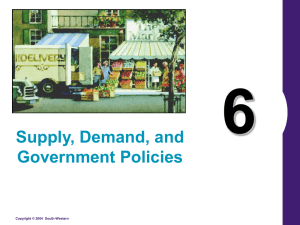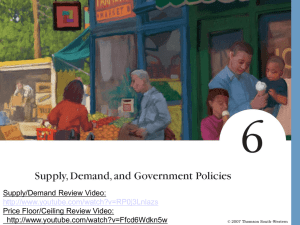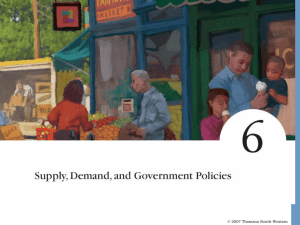Price Ceiling
advertisement
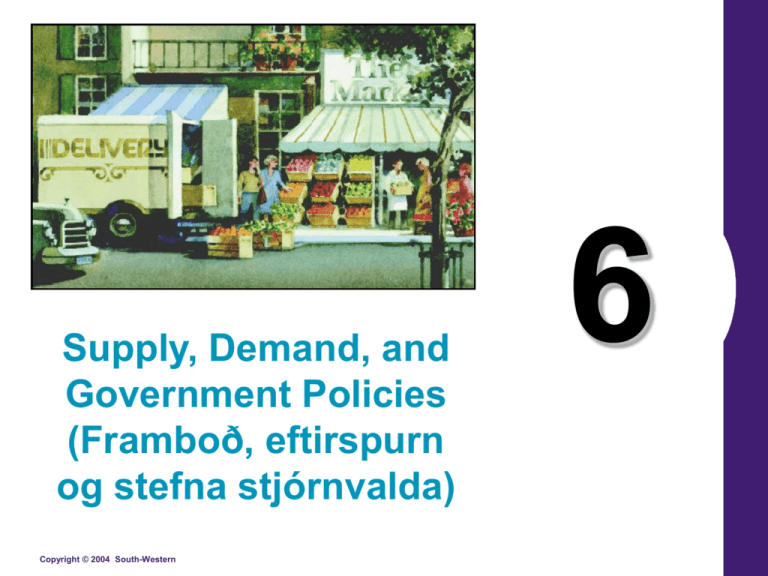
Supply, Demand, and Government Policies (Framboð, eftirspurn og stefna stjórnvalda) Copyright © 2004 South-Western 6 Supply, Demand, and Government Policies • In a free, unregulated (óreglusett) market system, market forces (kraftar markaðarins) establish (leggja grunn að) equilibrium prices and exchange quantities. • While equilibrium conditions may be efficient, it may be true that not everyone is satisfied. • One of the roles of economists is to use their theories to assist in the development of policies. Copyright © 2004 South-Western/Thomson Learning CONTROLS ON PRICES • Are usually enacted when policymakers believe the market price is unfair to buyers or sellers. • Result in government-created price ceilings and floors. Copyright © 2004 South-Western/Thomson Learning CONTROLS ON PRICES • Price Ceiling (verð þak) • A legal maximum on the price at which a good can be sold. • Price Floor (verð gólf) • A legal minimum on the price at which a good can be sold. Copyright © 2004 South-Western/Thomson Learning How Price Ceilings Affect Market Outcomes • Effects of Price Ceilings • A binding price ceiling creates • shortages because QD > QS. • Example: Gasoline shortage of the 1970s Copyright © 2004 South-Western/Thomson Learning Figure 2 The Market for Gasoline with a Price Ceiling (b) The Price Ceiling on Gasoline Is Binding Price of Gasoline S2 2. . . . but when supply falls . . . S1 P2 Price ceiling 3. . . . the price ceiling becomes binding . . . P1 4. . . . resulting in a shortage. Demand 0 QS QD Q1 Quantity of Gasoline Copyright©2003 Southwestern/Thomson Learning The Minimum Wage • An important example of a price floor (verðgólf) is the minimum wage (lágmarkslaun). Minimum wage laws dictate (stýra verðir niður í lægsta mögulega verð) the lowest price possible for labor that any employer may pay. Copyright © 2004 South-Western/Thomson Learning Figure 5 How the Minimum Wage Affects the Labor Market Wage Laun Labor Supply Equilibrium wage Labor demand 0 Equilibrium employment Quantity of Magn Labor vinnuafls Copyright©2003 Southwestern/Thomson Learning Figure 5 How the Minimum Wage Affects the Labor Market Wage Umframframboð (atvinnuleysi) Minimum wage Labor Supply Labor surplus (unemployment) Labor demand 0 Quantity demanded Quantity supplied Quantity of Labor Copyright©2003 Southwestern/Thomson Learning TAXES • Governments levy taxes (leggja á skatta) to raise revenue for public projects. Copyright © 2004 South-Western/Thomson Learning How Taxes on Buyers (and Sellers) Affect Market Outcomes Áhrif skatta á markaðinn • Taxes discourage market activity. • When a good is taxed, the quantity sold is smaller. • Buyers and sellers share the tax burden. Copyright © 2004 South-Western/Thomson Learning Elasticity and Tax Incidence • Tax incidence (dreifing skattbyrðar) is the study of who bears the burden of a tax. • Taxes result in a change in market equilibrium. • Buyers pay more and sellers receive less, regardless of whom the tax is levied on. Copyright © 2004 South-Western/Thomson Learning Figure 6 A Tax on Buyers Price of Ice-Cream Price Cone buyers pay $3.30 Price 3.00 2.80 without tax Price sellers receive Supply, S1 Equilibrium without tax Tax ($0.50) A tax on buyers shifts the demand curve downward by the size of the tax ($0.50). Equilibrium with tax D1 D2 0 90 100 Quantity of Ice-Cream Cones Copyright©2003 Southwestern/Thomson Learning Elasticity and Tax Incidence • What was the impact of tax? • Taxes discourage market activity. • When a good is taxed, the quantity sold is smaller. • Buyers and sellers share the tax burden. Copyright © 2004 South-Western/Thomson Learning Figure 7 A Tax on Sellers Price of Ice-Cream Price Cone buyers pay $3.30 3.00 Price 2.80 without tax S2 Equilibrium with tax S1 Tax ($0.50) A tax on sellers shifts the supply curve upward by the amount of the tax ($0.50). Equilibrium without tax Price sellers receive Demand, D1 0 90 100 Quantity of Ice-Cream Cones Copyright©2003 Southwestern/Thomson Learning




